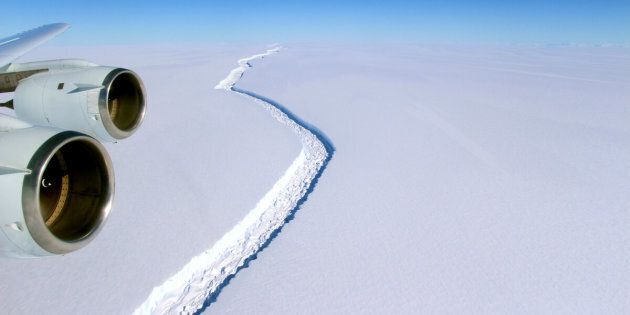

Scientists have observed a new rift in Antarctica’s Larsen C ice shelf that could soon lead to the calving of one of the biggest icebergs on record.
A secondary branch has split off from a 100-mile-long crack in the ice shelf that’s been growing since 2010, researchers with the United Kingdom-based Project MIDAS announced this month. Project MIDAS tracks the effects of climate change on the Larsen C.
That new rift, which is about 6 miles long, has forked toward the ice-front, or the region where the shelf meets the ocean.
“As of May 1, 2017, we have observed a significant change in the rift on the Larsen C ice shelf,” researchers with Project MIDAS wrote. “While the previous rift tip has not advanced, a new branch of the rift has been initiated [approximately] 10km behind the previous tip, heading towards the ice-front. This is the first significant change to the rift since February of this year.”
The main crack drew attention earlier this year, when scientists said it had grown more than 10 miles over a few weeks in December and an additional 6 miles in the first three weeks of January. Adrian Luckman, the lead researcher behind the project, declared at the time that a calving would be “inevitable.”
“When it calves, the Larsen C Ice Shelf will lose more than 10 percent of its area to leave the ice front at its most retreated position ever recorded; this event will fundamentally change the landscape of the Antarctic Peninsula,” he wrote in a blog post.
Scientists aren’t exactly sure when the shelf will separate, Mashable notes. But Luckman said in January that he’d be “amazed” if it didn’t break away in mere months, and rhetoric usually has a not-if-but-when tone.
Despite a lack in forward progress at the main rift, it has been steadily separating from the rest of the shelf by a few meters in width per day. The primary fork has currently reached an area of soft ice, called a suture zone, that has slowed its progress, according to the BBC.
Luckman told the outlet it’s possible the new crack, which started branching about 6 miles behind the main fork, veered into a patch of more breakable ice as the shelf has slowly been wrenched apart.
“Because the rift tip was in this area of basically softer ice that is very difficult to fracture, then the stresses have been transferred elsewhere and something has given, i.e. it has fractured in some of the ice that is more vulnerable to breaking which happens to be about 10km further back than the current rift tip,” Luckman said.
MIDAS has said that when the section of the Larsen C breaks off, the rest of the ice shelf will be much more vulnerable to melting and could very well mirror what happened at its sister shelf, the Larsen B. That area “splintered and collapsed” over the course of a month in 2002, NASA said, causing almost the entire shelf to disappear. The agency noted it had never witnessed such a large area ― 1,250 square miles ― disintegrate so quickly.
